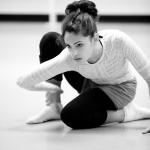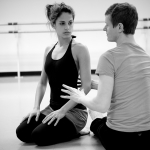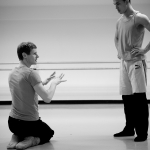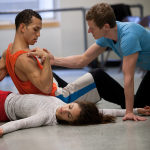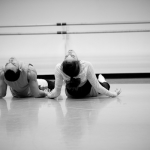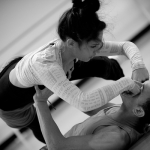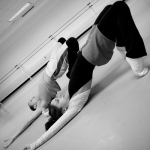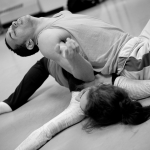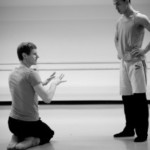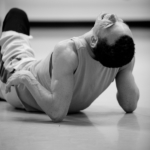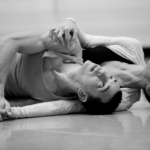It isn’t Nutcracker, that’s for sure. And Kylie Lewallen (who is dancing in two 2010 productions of the holiday favorite) is no sugar plum fairy in this riveting, dark piece by Olivier Wevers. Nor is her partner, Ty Alexander Cheng (a Nutcracker prince himself on occasion), any gallant cavalier here. Far from it. In Addiction, the pair of them are haunted by a monster outside themselves.
I think Olivier’s passion for bringing out the dramatic or emotional content of roles for which as a dancer he’s long been known—is, along with his classical European training, essential to his choreography. Nowhere is this clearer than in the three pas de deux (or duets as they tend to be called these days) in Monster, of which Addiction is the middle one. Olivier is a close scrutinizer of how ordinary people move, the way they telegraph mental states with their physical bodies. And he has the tools, garnered from long training and stage experience, to embody his observations in his work. In setting a piece on dancers, he pays extremely careful attention to the angle of a head, the expression of imploring fingers, casual interactions of friends, or the tight formation of a group bound into a societal box.
Olivier seldom mentions anyone’s facial expression in the course of rehearsal, though. It’s as if that is the province of the individual dancers, who consistently say he encourages them to be themselves. He is very articulate in showing what he wants, as well as in explaining both its spirit and the precise gesture needed to convey it. And these dancers are skilled enough at moving and carrying out instructions so that the nuances of expression appropriate to this person in this situation, however foreign or dire, follow naturally.
I keep being reminded of how I sometimes dream people into entirely apocryphal circumstances—yelling or being silly or sexy in a way I’ve never witnessed in waking life. How they act seems so real at the time, that I’m still angry or amused or half in love when I awake. Something similar seems to take place when Olivier choreographs. It’s as if his is the dreaming psyche, using a particular arrangement of positions and movements to invoke a situation or state of mind, and willing the dancers selves into it. They are then free to call on their own experience, or pure imagination, to behave as they really would if somehow transported there.
But what does one actually see in Monster/Addiction? How, via movement— as distinguished, if one can, from the expressions on the faces of the dancers, say, or the music, or what Olivier and Ty and Kylie have to say about it—does it communicate what it’s like to be lost to drugs?
Addiction unfolds on the ground and largely in a kind of zombie-like unison. The dancers never rise above their knees, except just before the end for him, and then it’s down again at once, in a tragic surrender to the force that’s killing them both. Classical ballet so often is, implicitly, in its very steps, designed to defy gravity. This piece is imbued with heaviness; weight is of its nature, and the couple cannot escape it.
A hand moves up across the face, over the nose (“not like wiping snot, it’s like snorting cocaine,” says Olivier, demonstrating). The jittery, repetitive moves of strung-out street people appear fleetingly here, not as realistic imitation but as suggestion, understated rather than flaunted, mere artifacts, by-products of what is happening to the bodies and souls of these two people. The weight of the dance conveys the strained, receding connection between them, alternately desperate and indifferent, until the chilling end of the piece.
There is almost no emotional connection between this pair. In her role, Kylie says, “Only at a couple of small moments am I even aware of this as an actual human being next to me.” The Ty character can’t reach out or even notice what is happening to his partner. And yet, they must dance in complete sync, impelled in parallel by the same force that has them both in its grip. The tiny instances where their movements diverge are that much more raw and poignant.
Addiction is accompanied by relentless, drilling, buzzing, sawing sounds, like static in the brain that prevents the outside world from penetrating. It is a painful piece, to dance and to watch.
Next up: Some thoughts on the dynamics of partnering…
Photographs by La Vie Photography: laViePhoto.com
For tickets to Shadows, Raincoats and Monsters, January 14-16, 2011 at Intiman Theatre:
